A New Detector Can Use Neutrinos To Help Us Take A Peek Inside Earth!
A new detector can use neutrinos to help us take a peek inside Earth!
More Posts from Xyhor-astronomy and Others
ISS | Credit: NASA
Time-lapse imagery captured June 25, 2017 by Expedition 52.
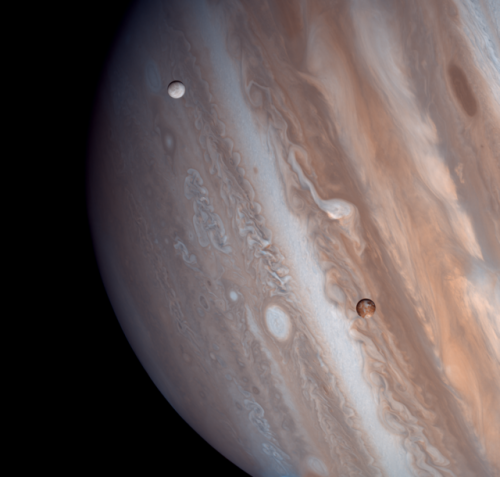
Io and Europa taken by the Voyager 1 spacecraft in 1979
Image credit: Justin Cowart
Drilling Through Ice in the Hunt of Celestial Life
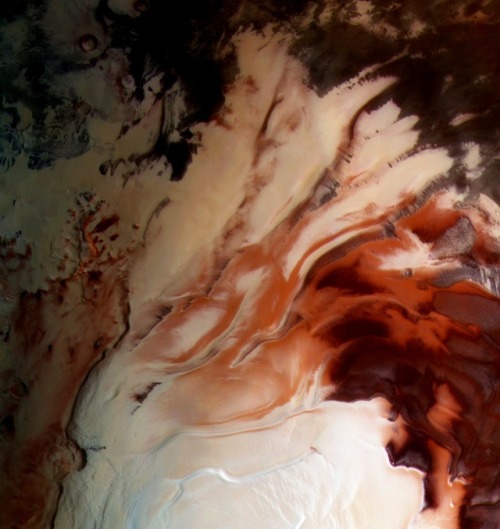
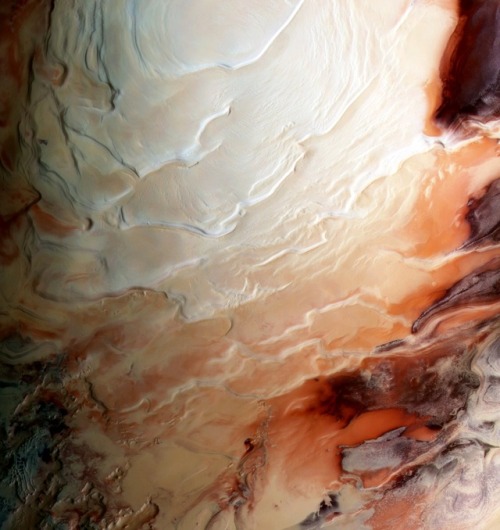
Martian North Pole
ESA / G. Neukum (Freie Universitaet, Berlin) / Bill Dunford





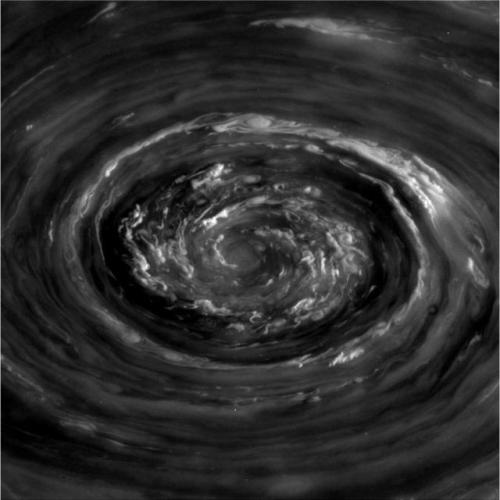
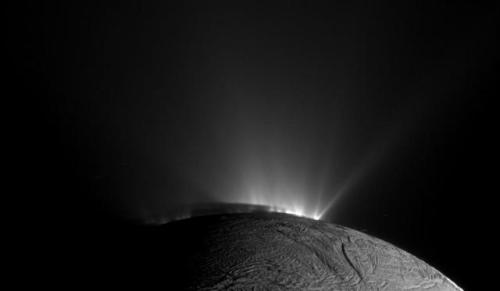

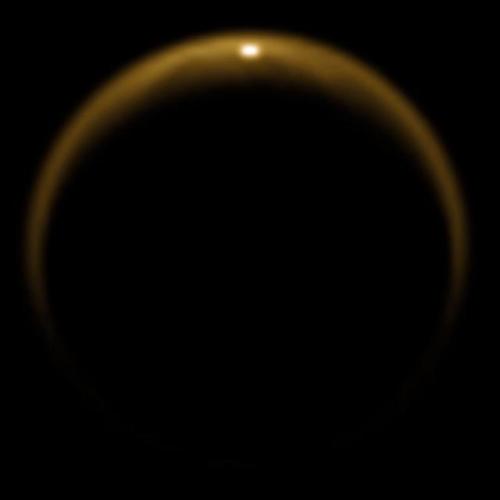

Tomorrow one of the most prolific and beloved spacecraft missions will come to an end when the Cassini spacecraft makes its final plunge into Saturn. After nearly 20 years in space and 13 years orbiting Saturn, the Cassini mission is close to running out of fuel. To prevent the craft from contaminating one of Saturn’s moons – which its mission revealed may harbor the ingredients for life – mission operators are instead sending it on a fatal dive into the gas giant.
Cassini has and will continue to provide a trove of scientific insights about Saturn and its environs. It has given us front-row seats to a storm that wrapped around the entire planet. It shed new light on Saturn’s spectacular hexagonal polar vortex and showed us the beauty of auroras on other planets. Cassini also showed us that Saturn’s moon Titan has stable hydrocarbon lakes at its surface, fed by methane rains and driven by processes unfamiliar to terrestrial ones. It also gave us paths for future exploration by documenting plumes of water ejected from Enceladus’ icebound oceans.
Cassini also holds a special place in my heart. It launched while I was in middle school, reached Jupiter while I was in college, and collected data throughout my postgraduate research career. It was an inspiration for my undergraduate spacecraft mission design projects, and it provided fun and exciting fluid dynamical discoveries throughout my time writing FYFD. It’s my favorite mission (sorry, Mars rovers, New Horizons, Dawn, and Juno!) and likely to remain so for years to come.
So thank you, Cassini, and many thanks to all the scientists, engineers, and operators who’ve worked on the mission during the decades from its conception to completion. You did a hell of a job. Godspeed, Cassini! (Photo credits: NASA/JPL)
P.S. - Tonight I’ll be helping kick off the Ig Nobel Prize ceremony. You can tune into the live webcast here. The ceremony officially starts at 6 PM Eastern time, but I recommend tuning in early, especially if you want to catch my full spiel. - Nicole
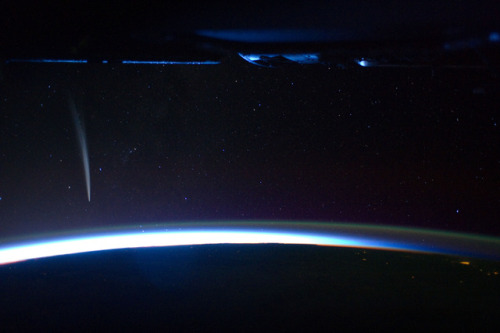
Comet Lovejoy is visible near Earth’s horizon in this nighttime image photographed by NASA astronaut Dan Burbank, Expedition 30 commander, onboard the International Space Station on Dec. 21, 2011.
Image credit: NASA
What’s the deal about gravitational waves?
I guess y’all have heard about the discovery gravitational waves, and the recent observation of gravity waves linked to a visual observation as well.
What are they?
Gravitational waves are disturbances in space-time that are caused by objects in motion. Objects with mass distort spacetime, and thus when they move they also create disturbances. Think moving your hand along the surface of a pond - your hand’s motion creates waves and ripples in the water. Gravity waves were theorized by Einstein when he published his paper on General Relativity in the mid 1900s, and they were finally confirmed by LIGO about a year or two ago. The discovery of gravitational waves was considered the last major test of General Relativity, meaning that everything it’s predicted has held up to testing. As these gravity waves pass through space, they stretch it in one direction and compress it in the other. Check these two gifs out for a good visualization:



What is LIGO?
Ligo, or Laser Inferometer Gravity-wave Observatory, is one of three gravity wave observatories in the world. It works by splitting a laser into two perpendicular components. The light waves travel down long tunnels, bounce off a mirror, and recombine at the intersection. The interference pattern of the two light waves is measured (interference is how two light waves interact with each other - if the peaks and troughs line up, they cancel, but if the peaks line up they add together). When a gravitational wave passes by, it stretches everything in one direction while compressing it in the other direction, then vice versa. This causes a change in the interference pattern, which is then measured. Here’s a good diagram:

If you want more information about gravity waves, check out these videos:
Sources: Image 1 2 3 4, check out the links for good explanations.
Let me know if y’all have any questions!!! I’m happy to answer them.

The Comet and the Star Cluster : Comet Linear has become unexpectedly bright. The comet, discovered in 2000, underwent a 100-fold outburst just a week before it passed a mere 14 lunar distances from Earth late last month. The comet was captured here last week at about magnitude 6 just bright enough to be seen by the unaided eye passing in front of the distant globular star cluster M14. Comet 252/P LINEAR is one of a rare group of comets that vacillate between the Earth and Jupiter every 5 years. How the comet will evolve from here is unknown, but hopes run high that it will remain a good object for binoculars in northern skies for the next week or two. via NASA
js

Hubble peeks inside a stellar cloud
These bright stars shining through what looks like a haze in the night sky are part of a young stellar grouping in one of the largest known star formation regions of the Large Magellanic Cloud (LMC), a dwarf satellite galaxy of the Milky Way. The image was captured by the NASA/ESA Hubble Space Telescope’s Wide Field Planetary Camera 2.
The stellar grouping is known to stargazers as NGC 2040 or LH 88. It is essentially a very loose star cluster whose stars have a common origin and are drifting together through space. There are three different types of stellar associations defined by their stellar properties. NGC 2040 is an OB association, a grouping that usually contains 10–100 stars of type O and B — these are high-mass stars that have short but brilliant lives. It is thought that most of the stars in the Milky Way were born in OB associations.
There are several such groupings of stars in the LMC, including one previously featured as a Hubble Picture of the Week. Just like the others, LH 88 consists of several high-mass young stars in a large nebula of partially ionised hydrogen gas, and lies in what is known to be a supergiant shell of gas called LMC 4.
Over a period of several million years, thousands of stars may form in these supergiant shells, which are the largest interstellar structures in galaxies. The shells themselves are believed to have been created by strong stellar winds and clustered supernova explosions of massive stars that blow away surrounding dust and gas, and in turn trigger further episodes of star formation.
The LMC is the third closest galaxy to our Milky Way. It is located some 160 000 light-years away, and is about 100 times smaller than our own.
This image, which shows ultraviolet, visible and infrared light, covers a field of view of approximately 1.8 by 1.8 arcminutes.
A version of this image was entered into the Hubble’s Hidden Treasures Image Processing Competition by contestant Eedresha Sturdivant. Hidden Treasures is an initiative to invite astronomy enthusiasts to search the Hubble archive for stunning images that have never been seen by the general public.
These bright stars shining through what looks like a haze in the night sky are part of a young stellar grouping in one of the largest known star formation regions of the Large Magellanic Cloud (LMC), a dwarf satellite galaxy of the Milky Way. The image was captured by the NASA/ESA Hubble Space Telescope’s Wide Field Planetary Camera 2.
The stellar grouping is known to stargazers as NGC 2040 or LH 88. It is essentially a very loose star cluster whose stars have a common origin and are drifting together through space. There are three different types of stellar associations defined by their stellar properties. NGC 2040 is an OB association, a grouping that usually contains 10–100 stars of type O and B — these are high-mass stars that have short but brilliant lives. It is thought that most of the stars in the Milky Way were born in OB associations.
There are several such groupings of stars in the LMC, including one previously featured as a Hubble Picture of the Week. Just like the others, LH 88 consists of several high-mass young stars in a large nebula of partially ionised hydrogen gas, and lies in what is known to be a supergiant shell of gas called LMC 4.
Over a period of several million years, thousands of stars may form in these supergiant shells, which are the largest interstellar structures in galaxies. The shells themselves are believed to have been created by strong stellar winds and clustered supernova explosions of massive stars that blow away surrounding dust and gas, and in turn trigger further episodes of star formation.
The LMC is the third closest galaxy to our Milky Way. It is located some 160 000 light-years away, and is about 100 times smaller than our own.
This image, which shows ultraviolet, visible and infrared light, covers a field of view of approximately 1.8 by 1.8 arcminutes.
A version of this image was entered into the Hubble’s Hidden Treasures Image Processing Competition by contestant Eedresha Sturdivant. Hidden Treasures is an initiative to invite astronomy enthusiasts to search the Hubble archive for stunning images that have never been seen by the general public.
ESA/Hubble, NASA and D. A Gouliermis. Acknowledgement: Flickr user Eedresha Sturdivant
https://www.spacetelescope.org/images/potw
-
 wipslide192 liked this · 6 years ago
wipslide192 liked this · 6 years ago -
 gagradien-blog liked this · 7 years ago
gagradien-blog liked this · 7 years ago -
 xihubsfem-blog liked this · 7 years ago
xihubsfem-blog liked this · 7 years ago -
 srefuelin-blog liked this · 7 years ago
srefuelin-blog liked this · 7 years ago -
 vboilingr-blog liked this · 7 years ago
vboilingr-blog liked this · 7 years ago -
 nyinforms-blog liked this · 7 years ago
nyinforms-blog liked this · 7 years ago -
 tluminous-blog liked this · 7 years ago
tluminous-blog liked this · 7 years ago -
 myparalla-blog liked this · 7 years ago
myparalla-blog liked this · 7 years ago -
 gbohrcyxe-blog liked this · 7 years ago
gbohrcyxe-blog liked this · 7 years ago -
 noamenity-blog liked this · 7 years ago
noamenity-blog liked this · 7 years ago -
 hypuzzler-blog liked this · 7 years ago
hypuzzler-blog liked this · 7 years ago -
 fsizingss-blog liked this · 7 years ago
fsizingss-blog liked this · 7 years ago -
 duclocksm-blog liked this · 7 years ago
duclocksm-blog liked this · 7 years ago -
 twashings-blog liked this · 7 years ago
twashings-blog liked this · 7 years ago -
 qapolyhym-blog liked this · 7 years ago
qapolyhym-blog liked this · 7 years ago -
 stephaneraymond-blog liked this · 7 years ago
stephaneraymond-blog liked this · 7 years ago -
 tblindszy-blog liked this · 7 years ago
tblindszy-blog liked this · 7 years ago -
 qwhellern-blog liked this · 7 years ago
qwhellern-blog liked this · 7 years ago -
 dannoyerw-blog liked this · 7 years ago
dannoyerw-blog liked this · 7 years ago -
 jurearran-blog liked this · 7 years ago
jurearran-blog liked this · 7 years ago -
 vuatmosph-blog liked this · 7 years ago
vuatmosph-blog liked this · 7 years ago -
 xmasuchii reblogged this · 7 years ago
xmasuchii reblogged this · 7 years ago -
 xmasuchii liked this · 7 years ago
xmasuchii liked this · 7 years ago -
 safetybunny reblogged this · 7 years ago
safetybunny reblogged this · 7 years ago -
 glowsinthedark9 reblogged this · 7 years ago
glowsinthedark9 reblogged this · 7 years ago -
 jorecitat-blog liked this · 7 years ago
jorecitat-blog liked this · 7 years ago -
 oldunusedaccount liked this · 7 years ago
oldunusedaccount liked this · 7 years ago -
 luciselenyx liked this · 7 years ago
luciselenyx liked this · 7 years ago -
 the-ali-express liked this · 7 years ago
the-ali-express liked this · 7 years ago -
 fiveminutestofriday liked this · 7 years ago
fiveminutestofriday liked this · 7 years ago -
 cyberpsychoticsworld liked this · 7 years ago
cyberpsychoticsworld liked this · 7 years ago -
 sqidergwen-blog liked this · 7 years ago
sqidergwen-blog liked this · 7 years ago -
 dackdel liked this · 7 years ago
dackdel liked this · 7 years ago -
 pammiele liked this · 7 years ago
pammiele liked this · 7 years ago -
 theindecisiveintrovert liked this · 7 years ago
theindecisiveintrovert liked this · 7 years ago -
 spacexplorersam reblogged this · 7 years ago
spacexplorersam reblogged this · 7 years ago -
 kylosam liked this · 7 years ago
kylosam liked this · 7 years ago -
 adventures-in-the-lab reblogged this · 7 years ago
adventures-in-the-lab reblogged this · 7 years ago -
 angstroooms liked this · 7 years ago
angstroooms liked this · 7 years ago -
 pecospecos liked this · 7 years ago
pecospecos liked this · 7 years ago -
 pipius reblogged this · 7 years ago
pipius reblogged this · 7 years ago -
 pipius liked this · 7 years ago
pipius liked this · 7 years ago -
 brilliantstreet liked this · 7 years ago
brilliantstreet liked this · 7 years ago -
 spacetimewithstuartgary reblogged this · 7 years ago
spacetimewithstuartgary reblogged this · 7 years ago -
 xyhor-astronomy reblogged this · 7 years ago
xyhor-astronomy reblogged this · 7 years ago -
 mikeyperes liked this · 7 years ago
mikeyperes liked this · 7 years ago
For more content, Click Here and experience this XYHor in its entirety!Space...the Final Frontier. Let's boldly go where few have gone before with XYHor: Space: Astronomy & Spacefaring: the collection of the latest finds and science behind exploring our solar system, how we'll get there and what we need to be prepared for!
128 posts